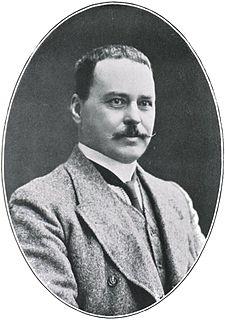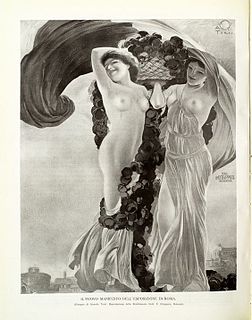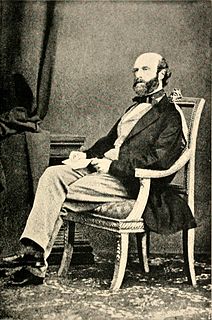
Brevet Colonel Sir (Samuel) Rickard Christophers was a British protozoologist and medical entomologist specialising in mosquitoes.

Sir Ronald Ross was a British medical doctor who received the Nobel Prize for Physiology or Medicine in 1902 for his work on the transmission of malaria, becoming the first British Nobel laureate, and the first born outside Europe. His discovery of the malarial parasite in the gastrointestinal tract of a mosquito in 1897 proved that malaria was transmitted by mosquitoes, and laid the foundation for the method of combating the disease. He was a polymath, writing a number of poems, published several novels, and composed songs. He was also an amateur artist and natural mathematician. He worked in the Indian Medical Service for 25 years. It was during his service that he made the groundbreaking medical discovery. After resigning from his service in India, he joined the faculty of Liverpool School of Tropical Medicine, and continued as Professor and Chairman of Tropical Medicine of the institute for 10 years. In 1926 he became Director-in-Chief of the Ross Institute and Hospital for Tropical Diseases, which was established in honour of his works. He remained there until his death.

Alfred William Alcock was a British physician, naturalist, and carcinologist.

Aleardo Terzi (1870–1943) was an Italian illustrator and artist.

Francis Walker was an English entomologist. He was born in Southgate, London, on 31 July 1809 and died at Wanstead, England on 5 October 1874. He was one of the most prolific authors in entomology, and stirred controversy during his later life as his publications resulted in a huge number of junior synonyms.

Alexander Henry Haliday was an Irish entomologist. He is primarily known for his work on Hymenoptera, Diptera, and Thysanoptera, but worked on all insect orders and on many aspects of entomology.
Alexander Graham Bell Fairchild was an American entomologist, and a member of the Fairchild family, descendants of Thomas Fairchild of Stratford, Connecticut and one of two grandsons of the scientist and inventor, Alexander Graham Bell, for whom he was named, and son of David Fairchild, a botanist and plant explorer.


Sir Patrick Manson was a Scottish physician who made important discoveries in parasitology, and was a founder of the field of tropical medicine. He graduated from University of Aberdeen with degrees in Master of Surgery, Doctor of Medicine and Doctor of Law. His medical career spanned Taiwan, China, Hong Kong, and London. He discovered that filariasis in humans is transmitted by mosquitoes. This is the foundation of modern tropical medicine, and he is recognized with an epithet "Father of Tropical Medicine". His discovery directly invoked the mosquito-malaria theory, which became the foundation in malariology. He eventually became the first President of the Royal Society of Tropical Medicine and Hygiene. He founded the Hong Kong College of Medicine for Chinese and the London School of Hygiene & Tropical Medicine.

Frederick Vincent Theobald FES was an English entomologist and "distinguished authority on mosquitoes". During his career, he was responsible for the economic zoology section of the Natural History Museum, London, vice-principal of the South-Eastern Agricultural College at Wye, Kent, Professor of Agricultural Zoology at London University, and advisory entomologist to the Board of Agriculture for the South-Eastern district of England. He wrote a five volume monograph and sixty scientific papers on mosquitoes. He was recognised for his work in entomology, tropical medicine, and sanitation; awards for his work include the Imperial Ottoman Order of Osmanieh, the Mary Kingsley Medal, and the Victoria Medal of Honour, as well as honorary fellowships of learned societies.
Ernest Edward Austen was an English entomologist specialising in Diptera and Hymenoptera.
Terzi is a surname. People with this surname include:

George Carmichael Low was a Scottish parasitologist.
George Henry Evans Hopkins OBE was an English entomologist.
Ernest Gerald Gibbins was a British entomologist who worked on insects of medical importance. He described 26 new species. While researching tropical diseases in Uganda, he was speared to death by tribesmen who believed that he would use their blood samples for witchcraft.
Andrea Terzi was an Italian painter and engraver.

Mosquito-malaria theory was a scientific theory developed in the latter half of the 19th century that solved the question of how malaria was transmitted. The theory basically proposed that malaria was transmitted by mosquitoes, in opposition to the centuries-old medical dogma that malaria was due to bad air, or miasma. The first scientific idea was postulated in 1851 by Charles E. Johnson, who argued that miasma had no direct relationship with malaria. Although Johnson's hypothesis was forgotten, the arrival and validation of the germ theory of diseases in the late 19th century began to shed new lights. When Charles Louis Alphonse Laveran discovered that malaria was caused by a protozoan parasite in 1880, the miasma theory began to subside.

Elizabeth Nesta "Pat" Marks was an Australian entomologist who described 38 new mosquito species, as well as new species of fruit flies, bugs, cockroaches and ticks. She had a PhD in insect physiology from the University of Cambridge and was a member of the Royal Entomological Society of London.
Prof Alexander John Haddow CMG FRS FRSE FRCPSG FRES. FRS CMG was a Scottish entomologist recognised for his work at the Uganda Virus Research Institute, including the discovery of the Zika virus, and research into the insect vectors of the yellow fever virus. Other notable work included relating the incidence of Burkitt's lymphoma to climatic conditions and the discovery of several previously unknown viruses in east Africa, particularly arboviruses.

Louis Westenra Sambon was an Italian-English physician who played important roles in understanding the causes (etiology) of diseases. He described many pathogenic protozoans, insects, and helminths including the name Schistosoma mansoni for a blood fluke. He was an authority on the classification of parasitic tongue worms called Pentastomida (Linguatulida), and one of the genus Sambonia is named after him.













